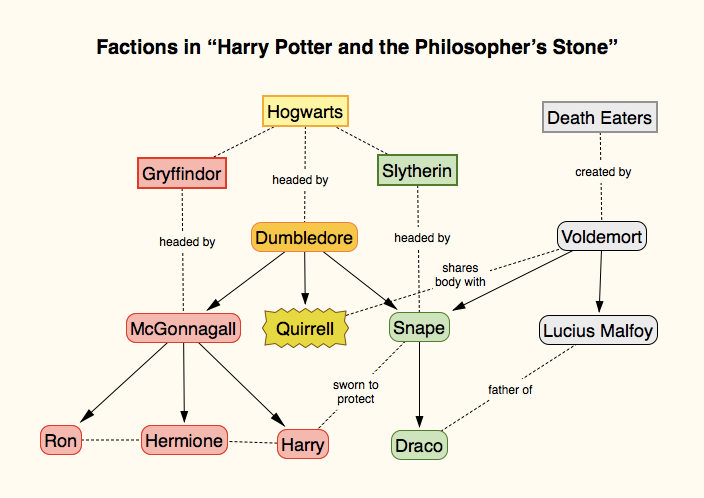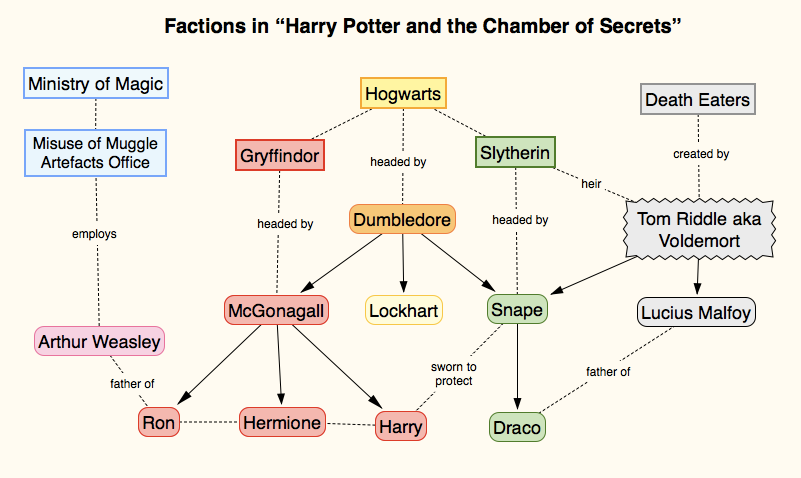Diagramming your book's conflicts
This weekend I knuckled down to sorting out the overall plot of my work-in-progress. I have a setting, several main characters and some ideas for conflicts, but nothing was pinned down, hence my struggles to get on with writing the book. This is pretty par for the course with me; I tend to get bogged down in plot possibilities because there are so many directions the story could go in and I can't decide which one is best!
I started with my usual process of "thinking aloud" on paper, and suddenly the pieces began to fall into place: I knew who my main opposing factions would be, and that there would be factions within those factions, divided loyalties, betrayals, etc. It was starting to get quite complicated, so at the suggestion of my writer friend Adrian Faulkner I broke out my trial copy of Scapple, a simple diagramming program for Mac and Windows, produced by those lovely people who brought us Scrivener.
I started drawing boxes, connecting them with arrows and colour-coding them by their allegiances, and I realised this was a really useful tool for fleshing out your conflicts. I'm not usually big on mind-maps for brainstorming, as they don't help me figure out why people are connected, but it turns out they're excellent for summarising the results of my brainstorming - and for provoking new brainstorming to fill in the gaps! It's not really anything new, I guess, but I was so excited by how much clearer my ideas became that I wanted to share my methodology.
Obviously I can't show you the diagram for Serpent's Tooth—spoilers!—so instead I've mocked up some examples using the first two Harry Potter books. This series has the advantage that a) it's extremely well known and b) the conflicts are simple enough to fit in a small diagram but complex enough to illustrate the principles well.
I've chosen to follow a few simple conventions for my diagrams:
- Square-edged box - an organisation, group or faction
- Round-edged box - an individual
- Arrow - a superior-to-inferior relationship in a formal hierarchy (e.g. boss-to-employee)
- Dotted line - any other kind of relationship
I've also marked the principle villain in each book with a jagged-edged box, just for clarity.
First, let's look at Harry Potter and the Philosopher's Stone:

There are two principle factions at Hogwarts, Gryffindor and Slytherin, which I've coloured red and green respectively (based on their house colours). Note that whilst Hogwarts in general is represented by yellow, I've chosen orange for Dumbledore because he has a distinct bias towards Gryffindor. Professor Quirrell on the other hand is a dirty yellow, to signify his corruption by Voldemort. Quirrell is also the main antagonist in this book, since Voldemort is still lacking a body of his own.
Already we can see that Snape is going to be a crucial character because he belongs to two opposing factions. I think this diagram also shows why the series appealed so much to adults; although the action is focused on the younger generation, the most interesting conflicts revolve around the older wizards, giving the adult characters a far more prominent role than is usual in children's fiction.
Moving on to Harry Potter and the Chamber of Secrets, we see the conflict expanding beyond Hogwarts into the wider world:

The new Defence Against the Dark Arts teacher, Gilderoy Lockhart, is nowhere near as central to the plot as Quirrell was; instead the main villain is now Voldemort, or rather his past self Tom Riddle and his diary/horcrux.
Now you're probably wondering why I bothered to include the Ministry of Magic on my chart - after all, it doesn't play much of a role in this book. I would indeed omit it, except that it's a great opportunity to illustrate what I discovered whilst working on my own book's conflicts.
When Ron steals the flying car, it seems at the time like nothing more than a fun incident, but it also serves to introduce the ministry and hint at conflict between its authoritarian attitude and the Weasleys' (and Dumbledore's) more laid-back approach. If however Rowling had decided to expand this storyline in Chamber of Secrets, there's a problem with the diagram as it stands: there is no-one who personifies the ministry, and therefore no-one whom the protagonists can confront.
What Rowling would need to do is add senior figures at the ministry: Mr Weasley's boss, Barty Crouch Sr, and perhaps even the Minister for Magic himself. And of course she does exactly this in later books, fleshing out the ministry's hierarchy as its members become almost as big a threat to Harry and his friends as the Death Eaters.
My point is that if you draw up your conflict diagram and discover that an important faction (i.e. one with a major stake in the plot) has no representative, that's a good indication that you need to create such a character. Without them, the faction will be a faceless organisation and thus far harder for your protagonists to interact with. Secondly, if your factions are monolithic blocks with no disagreements or divided loyalties, you're missing out on some great story opportunities. Finally the diagram is a good way to get a grasp of all the connections between characters, and helps you to see where additional connections might enrich the plot.
Of course my "discovery" is hardly headline news, but on the other hand I've read many, many books of writing advice and yet I don't recall seeing any that explain in a simple, visual way how to populate a plot with the characters you need. Maybe everyone else finds it intuitive, but surely I can't be the only writer in the world who sometimes struggles with defining conflicts?
Anyway let me know if you find it useful!